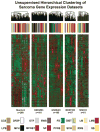Gene expression profiling for the investigation of soft tissue sarcoma pathogenesis and the identification of diagnostic, prognostic, and predictive biomarkers
- PMID: 19412622
- PMCID: PMC4847139
- DOI: 10.1007/s00428-009-0774-2
Gene expression profiling for the investigation of soft tissue sarcoma pathogenesis and the identification of diagnostic, prognostic, and predictive biomarkers
Abstract
Soft tissue sarcomas are malignant neoplasms derived from mesenchymal tissues. Their pathogenesis is poorly understood and there are few effective treatment options for advanced disease. In the past decade, gene expression profiling has been applied to sarcomas to facilitate understanding of sarcoma pathogenesis and to identify diagnostic, prognostic, and predictive markers. In this paper, we review this body of work and discuss how gene expression profiling has led to advancements in the understanding of sarcoma pathobiology, the identification of clinically useful biomarkers, and the refinement of sarcoma classification schemes. Lastly, we conclude with a discussion of strategies to further optimize the translation of gene expression data into a greater understanding of sarcoma pathogenesis and improved clinical outcomes for sarcoma patients.
Conflict of interest statement
Figures


References
-
- Weiss SW, Goldblum JR. Enzinger and Weiss’s soft tissue tumors. 5. Mosby/Elsevier; Philadelphia: 2008.
-
- Fletcher CDM, Unni KK, Mertens F, et al. Pathology and genetics of tumours of soft tissue and bone. IARC Press; Lyon: 2002.
-
- Wendtner CM, Abdel-Rahman S, Krych M, et al. Response to neoadjuvant chemotherapy combined with regional hyperthermia predicts long-term survival for adult patients with retroperitoneal and visceral high-risk soft tissue sarcomas. J Clin Oncol. 2002;20:3156–3164. - PubMed
-
- O’Sullivan B, Davis AM, Turcotte R, et al. Preoperative versus postoperative radiotherapy in soft-tissue sarcoma of the limbs: a randomised trial. Lancet. 2002;359:2235–2241. - PubMed
-
- Borden EC, Baker LH, Bell RS, et al. Soft tissue sarcomas of adults: state of the translational science. Clin Cancer Res. 2003;9:1941–1956. - PubMed
Publication types
MeSH terms
Substances
Grants and funding
LinkOut - more resources
Full Text Sources
Medical
Miscellaneous

